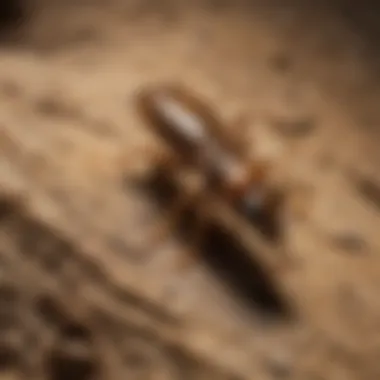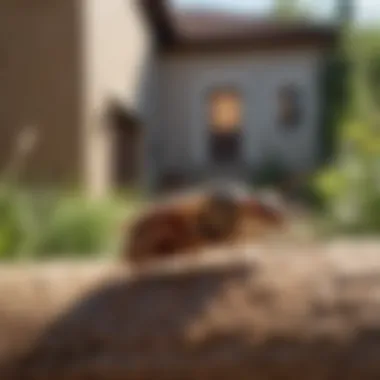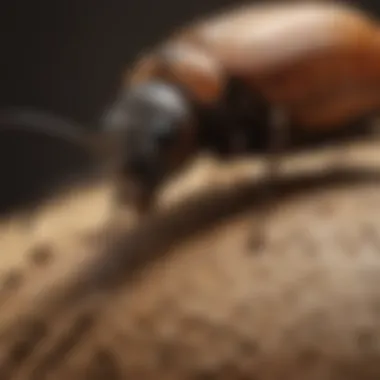Southeastern Termite and Pest Control Guide


Intro
Pest control is no small potatoes, especially in the southeastern United States where the balmy weather creates an ideal breeding ground for various household nuisances. Knowing how to tackle these critters before they become a full-blown invasion is crucial. From termites that gnaw on the very framework of your home to roaches that scurry across your kitchen floor, understanding the nuances of pest management is essential for every homeowner.
This guide aims to shed light on effective ways to identify, prevent, and address pest issues common to this region. By delving into the biology of pests, signs of infestation, and the eco-friendly methods that can be employed, we'll help you equip your home against these unwelcome guests. Armed with this knowledge, homeowners can tackle pest challenges head-on, ensuring a safe and clean living environment.
Pest Identification
Understanding your enemy is half the battle. To effectively combat pests, one must first be able to identify them. This section highlights several common household pests and the signs that indicate their presence.
Common Household Pests
In the southeastern U.S., many pests consider your home a buffet. Here are a few of the regular suspects:
- Termites: Especially prevalent in warm, humid climates, these pests can wreak havoc by consuming wood and cellulose materials.
- Roaches: Known to thrive in damp places, these critters can spread disease and are often a source of discomfort for households.
- Ants: Particularly the Argentine ant and the carpenter ant, these pests can invade in swarms, seeking food or new nesting sites.
- Bed Bugs: Once thought to be extinct, these pests are making a comeback, hiding in bedding and luggage.
Signs of Infestation
Recognizing the signs of pests early on can save a homeowner both time and money. Here’s what to look for:
- Termites: Look for mud tubes, discarded wings, or hollow-sounding wood.
- Roaches: Droppings, egg cases, and a musty odor can indicate an infestation.
- Ants: If you spot piles of sawdust or small holes in wood, you may have carpenter ants.
- Bed Bugs: Bites on the skin or rusty spots on sheets can clue you into a bed bug presence.
"An ounce of prevention is worth a pound of cure." - Benjamin Franklin.
With this foundational understanding of common household pests and their warning signs, it’s easier to be vigilant and proactive. Next up, let's look at how to prevent these pests from making themselves at home.
Prevention Methods
Preventing a pest infestation is much easier than dealing with one. Some simple adjustments around the house can go a long way. Here are effective strategies for keeping your home pest-free.
Environmental Modifications
Adjusting your surroundings can deter pests:
- Seal Cracks and Crevices: Small openings can be highways for pests. Use caulk to fill gaps.
- Maintain Landscaping: Keep vegetation trimmed away from the home to reduce hiding spots.
- Remove Standing Water: Fix leaks and ensure no water accumulates outside; pests love a good drink.
Home Maintenance Tips
Regular upkeep can bolster your defenses:
- Regular Cleaning: Frequent vacuuming and wiping down surfaces can deter pests looking for food crumbs.
- Inspect Wood: Regularly check wooden furniture and structures for signs of wear or damage that could signal termites.
- Proper Food Storage: Maintain airtight containers to keep food from pest scavengers.
DIY Pest Control Solutions
Feeling hands-on? There are several DIY methods to combat pests without resorting to heavy chemicals that could harm your home environment.
Natural Remedies
Using household items can effectively keep pests at bay:
- Vinegar: A mix of vinegar and water can repel ants.
- Essential Oils: Oils like peppermint can deter spiders and other bugs when sprayed around doorways.
- Boric Acid: This common substance can be sprinkled in areas prone to roaches and ants.
DIY Traps and Barriers
Creating simple traps can minimize pest populations:
- Sticky Traps: Place these near suspected entry points to catch roaming pests.
- Soap Traps: A mix of dish soap and water in a shallow dish can trap insects like fruit flies.
Taking these preliminary steps ensures that your home remains a sanctuary, free from unwanted pests. Remember, when in doubt, professional help is just a call away, particularly for serious infestations.
Let’s dig deeper into the eco-friendly pest control methods that modern pest control philosophies embrace.
Intro to Southeastern Pest Challenges
In the southeastern United States, pest control is not merely a seasonal chore, but a persistent challenge that shapes the lives of homeowners and tenants alike. Understanding the complex landscape of pest management in this region is crucial for anyone looking to maintain a safe and comfortable living environment. From the relentless march of termites through wooden structures to the invasive presence of various insects and rodents, the importance of addressing these challenges cannot be overstated.
The southeastern climate—a blend of humidity and warmth—creates an optimal breeding ground for a variety of pests. This not only affects residential properties but also commercial spaces, leading to economic implications that can ripple through industries dependent on timber and agriculture. Often, individuals may feel overwhelmed by options when it comes to pest control, leading to a confluence of home remedies and professional treatments without a solid understanding of their efficacy or potential pitfalls.
Highlighting specific elements of pest identification and tailored treatments can arm homeowners with the information necessary to tackle infestations effectively. The benefits stretch beyond the maintenance of structures; they encompass health considerations, environmental impacts, and economic vitality. Knowing when to take action, whether through preventive measures or seeking professional help, equips one with tools for practical pest management.
Geographic and Climatic Influences on Pest Populations
The geography and climate of the southeastern United States, often characterized by its varying topography—from coastal regions to the mountainous areas of the Appalachians—profoundly influence pest populations. It isn't just the seasonal weather but rather a confluence of factors that shapes the types of pests prevalent in these areas. Hot, humid summers provide a fertile ground for insects such as termites and mosquitoes, while milder winters can allow certain species to survive longer than in colder climates.
In essence, the local ecology plays a significant role in determining pest behavior and lifecycle, which in turn affects how homeowners can manage these challenges. For example, subterranean termites thrive in moist environments, making areas with poor drainage more susceptible to infestations. Meanwhile, properties near water bodies may experience higher mosquito populations, requiring targeted management practices.
Additionally, being aware of seasonal shifts is pivotal. The onset of spring often sees the awakening of bug activity, leading to a stark rise in infestations. Understanding these cycles can lead to better preparation and response strategies for homeowners, allowing them to take proactive measures before issues escalate.
The Economic Impact of Pest Infestations
The economic implications of pest infestations in the Southeast are staggering and multifaceted. Small infestations can escalate into larger issues that demand costly repairs and pest management services. For instance, termite damage alone can lead to repairs averaging thousands of dollars, not to mention the potential decrease in property value. Not only do homeowners bear the brunt of these costs, but the broader community may feel the repercussions through elevated insurance premiums and local economic downturns related to pest control businesses.
According to a study, the national cost of pest management in homes and businesses is well into the billions annually. In the Southeast, where the warmth and moisture create a conducive environment for pests, these numbers can rise significantly. The agricultural sector is particularly vulnerable, with crops subject to devastation from pest infestations—compromising not just the farmer's profit margins but also the local economy reliant on agricultural commerce.
In summary, the influence of termites and other pests extends beyond immediate annoyances or property damage; they pose a real threat to economic stability on multiple fronts. Addressing these challenges with a comprehensive understanding not only enhances personal living spaces but also contributes positively to the larger community.
"Effective pest control is not just about dealing with the swarm of insects today, it’s about ensuring a secure tomorrow for communities and households alike."
In wrapping up this introduction to southeastern pest challenges, remember that knowledge is power. By familiarizing oneself with how geographic and climatic factors interact with pest populations and recognizing the potential economic fallout from infestations, homeowners can take crucial steps to secure their assets and maintain peace of mind.
Understanding Termites
In the realm of pest control, grasping the details about termites is a key factor to thwarting their potential destruction. Termites are not just pestilent critters; they are; in many ways, sophisticated organisms with complex social structures. They can wreak havoc on wooden structures if left unchecked. Understanding their biology and behavior helps homeowners anticipate and prevent infestations before they spiral out of control. Through this article, we will shed light on various aspects of termites, making clearer the benefits of education in this area.


Identifying Common Southeastern Termite Species
Recognizing termite species is incredibly important when it comes to effective management strategies. The southeastern United States girds itself with environments that foster the growth of various termite types.
Subterranean Termite
Subterranean termites are perhaps the most recognized pests, especially in the Southeast, where they thrive beneath the soil surface. Their colonies, hidden underground, can span vast areas and contain thousands of individuals. One notable characteristic of subterranean termites is their affinity for moisture, which draws them to structures with poor drainage.
What sets these termites apart is their ability to cause extensive damage while going largely unnoticed until it’s too late. Their penchant for nesting in moist areas underscores the necessity for vigilant monitoring and preventive action. Homeowners should be aware that they can infiltrate homes through even the tiniest cracks in foundations.
Drywood Termite
Drywood termites, as the name implies, can establish themselves in wooden structures, completely bypassing the need for soil contact. This independence from moisture makes them particularly insidious, as they can thrive even in drier conditions.
A distinguishing feature of drywood termites is that they often create small exit holes in wood, resembling tiny pinpricks. These exit holes are a telltale sign that can alert homeowners apprehensively. Due to their ability to cause damage internally, by the time signs become visible, considerable destruction may have already occurred.
Formosan Termite
Formosan termites are often painted as one of the most aggressive termite types. Their rapid reproductive cycle enables colony growth that can reach into the millions. They prefer structures that are moist and often invade from underground galleries.
The unique aspect of Formosan termites lies in their sheer appetite for destruction. They can cause significant damage within short spans, making them a formidable foe for any property owner. Awareness here is crucial, as these creatures can undermine the integrity of homes, posing risk not only to property but to safety as well.
Termite Biology and Behavior
Understanding the biology of termites helps paint a clearer picture of their destructive capabilities. This knowledge is not just academic; it's remarkably practical in preventing and managing infestations more effectively.
Colony Structure
At the heart of termite society lies a well-defined colony structure. Typically, a colony comprises a queen, king, workers, and soldiers, each fulfilling unique roles that ultimately contribute to the health and expansion of the colony.
The ability to function cohesively as a community allows termites to thrive in various environmental conditions. Moreover, understanding the structure helps homeowners know which types of treatments may work best depending on the situation.
Reproductive Cycle
The reproductive cycle of termites pans out in a way that can astonish even seasoned pest control experts. Once conditions are ripe, a queen can produce thousands of eggs in a single day. This swift reproduction rate can quickly escalate what may appear to be a minor issue into an overwhelming infestation.
Households that do not regularly monitor for signs of termite activity may find themselves overwhelmed. Recognizing peak reproductive times, which often coincide with warmer months, can steer preventive measures well in advance.
Feeding Habits
The feeding habits of termites also play a crucial role in their influence on wooden structures. They primarily feast on cellulose, a component found in wood and plants. This appetite can lead to considerable destruction when infestations are not managed properly.
Their unique feeding techniques, which often encompass tunneling through wood, dictate how damage manifests. Homeowners must remain vigilant as damaged wood may appear hollow or may be accompanied by notable sounds or debris. With correct understanding, both monitoring and intervention strategies can be developed more effectively.
Identifying Pest Infestations
Recognizing the signs of a pest infestation is crucial in maintaining a healthy and safe home environment, particularly in the Southeastern United States, where the warm climate breeds a variety of pests. Proper identification enables homeowners to address issues quickly, reducing the potential damage caused by insects like termites or common household nuisances such as rodents and roaches. Knowing how to spot early warning signs helps in taking preventative measures and can save homeowners substantial repair costs and distress.
Signs of Termite Activity
Frass or Termite Droppings
Frass, commonly referred to as termite droppings, is one of the primary indicators of termite infestation. This excrement is often found in small piles, resembling sawdust, near areas where termites are active. The presence of frass is significant because it usually means that termites are actively tunneling within the structure of your home.
The key characteristic of frass is its grainy texture, made up of wood remnants, often showing the diet choice of the pests. Observing frass not only alerts homeowners to potential damage but also guides pest control measures. Unique to frass is its ability to differentiate between termite species; for example, the droppings from drywood termites tend to be more compact than those from subterranean termites.
Advantages of recognizing this telltale sign include early detection and timely intervention, which can prevent more severe infestations down the line. Ultimately, knowing what to look for saves time and resources in eliminating these wood-eating intruders.
Wing Discarding
Another prominent sign of termite activity is the presence of discarded wings around the home. After a swarm leaves the colony to establish a new one, they shed their wings, leaving them scattered around entry points.
The key characteristic here is that discarded wings are often found in nests or near windows and doors, tapping into the potential for infestation throughout the house. The unique feature of these wings is their uniform size and shape, which can be distinctive when compared to other flying insects. Recognizing wing discard is essential for detecting the potential establishment of new colonies before they can take hold.
The benefits of noting discarded wings revolve around prompt action. By investigating and possibly treating the area, homeowners can deter further colonization and reduce the likelihood of significant structural damage.
Damage to Wood Structures
Damage to wooden structures is perhaps the most alarming sign of a termite presence. Hollowed-out wood, sagging frames, and visible galleries can indicate extensive feeding activity by termites.
The key characteristic of this damage is that it often appears in patches and typically goes unnoticed until major deterioration has occurred. For homeowners, this kind of damage not only poses structural risks but can also lead to substantial repair costs. The unique feature of wood damage from termites is its often hidden nature; while some damage may be visible, much occurs within the wood, making early signs more subtle.
Advantages of being aware of wood damage include an enhanced understanding of the urgency in treatment. Quick intervention can facilitate repairs and even prevent future infestations, reinforcing the necessity of timely action if any suspicious signs appear.
Common Household Pests in the Southeast
Ant Species
Ant species such as the Argentine ant and the Carpenter ant are prevalent troublemakers in the Southeastern region. Their ability to form large colonies makes them a concern for homeowners.
What stands out with these ants is their diverse behavior. While the Argentine ant prefers sweet substances, Carpenter ants can cause substantial damage by hollowing out wood. They can infiltrate homes undetected, often while foraging for food and creating nests in damp areas. The drawback of dealing with ants is that their colonies can expand quickly, meaning that by the time one sees a few ants, there could be hundreds more nearby.
Roaches
Roaches, particularly the American and German varieties, thrive in warm and humid conditions, making the Southeast their home. A telltale sign is the distinct musty odor these pests carry.
The key characteristic of roaches is their resiliency. They can survive in various environments and breed rapidly. The unique aspect is their nocturnal habits, often leading homeowners to become unaware of their presence until they get overwhelmed.
While roaches are mostly considered nuisance pests, their ability to contaminate food and surfaces poses health risks to inhabitants. Swift action is necessary to prevent an infestation from escalating, emphasizing the need for vigilant inspection and measures.
Rodents
Rodents, including mice and rats, are common uninvited guests in Southeastern homes. They find ways into buildings seeking shelter and food, often causing damage and transmitting diseases.
The key characteristic of rodents is their destructive behavior, evidenced by gnawed wires, chewed furniture, and droppings found around their nests. Their unique ability to reproduce swiftly makes it essential for homeowners to identify and act on signs of rodent activity quickly.


Additionally, while having a rodent issue can be distressing, it also serves as a prompt for homeowners to strengthen their preventative measures against future infestations. Identifying and addressing rodent entry points can lead to a more secure home environment.
Preventive Measures
Preventive measures play a pivotal role in safeguarding homes against pest infestations, especially in the southeastern United States. Take it from someone who’s had their fair share of pest woes, it’s always better to nip these issues in the bud rather than deal with an all-out invasion later on. By integrating simple home maintenance practices and effective landscaping techniques, homeowners can significantly reduce their vulnerability to pests.
Home Maintenance Practices
Proper Ventilation and Moisture Control
One of the most vital aspects contributing to a pest-free home is proper ventilation and moisture control. Without doubt, a damp and poorly ventilated environment creates an inviting haven for pests like termites and rodents. Ensuring adequate airflow helps to keep humidity levels in check. Homes with high humidity not only risk mold but also become breeding grounds for pests.
The key characteristic here is airflow—it drives away that stale, damp air which pests thrive on. This makes it a popular choice for many homeowners keen on proactive pest control.
A unique feature of proper ventilation is the utilization of exhaust fans in kitchens and bathrooms. Moreover, regularly checking for leaks can uncover hidden moisture sources that entice pests. However, keep in mind that excessive ventilation can sometimes lead to drafts, especially in colder months. So, balance is essential.
Sealing Entry Points
Let’s face it: pests are crafty. If there’s a way in, they’ll find it. Sealing entry points is an essential step in keeping your home safe from unwanted intruders. This encompasses everything from gaps around windows and doors to cracks in your foundation. The goal here is clear–to make it tough for pests to enter your home.
The highlight of sealing entry points is its simplicity: a caulk gun and a little time can dramatically increase your pest defense. It’s a beneficial approach because once you seal those gaps, the chances of a pest invasion drop significantly.
A unique feature of this process is its affordability; you won’t have to break the bank to seal those pesky openings. However, it may require regular maintenance as wear and tear can loosen seals over time.
Regular Inspections
Regular inspections are like your friendly neighborhood watchdog against pest problems. They help catch any signs of trouble early on, allowing homeowners to take action before a small issue turns into a big fiasco. These inspections can range from inspecting the crawl spaces under the house to checking for telltale signs of pests in bathrooms and kitchens.
What makes regular inspections so crucial is the ongoing peace of mind they provide. Continual vigilance pays off, as spotting any wood damage or droppings can save you considerable time and money later.
One unique feature of this practice is using a checklist tailored to local pest risks. This allows a focused approach, ensuring that all potential problem areas are addressed. On the flip side, they can be time-consuming, particularly if conducted without a plan.
Landscaping Techniques for Pest Control
Siting Plants Appropriately
Plant placement isn’t just for aesthetics; it has a serious impact on pest control. Siting plants appropriately is about understanding which plants thrive in certain spots and which ones are susceptible to pests. When the right plants are placed in strategic locations, they create natural barriers against potential pests.
The highlight of this technique is the synergistic relationship between plants. For instance, companion planting can deter pests while also supporting the other plants. It’s a beneficial option because it applies principles of natural pest deterrence, which can be quite effective.
However, be careful about which plants you place near your home; some may attract unwanted pests rather than repel them. It requires a bit of planning and research to get it right.
Choosing Pest-Resistant Varieties
In the battle against pests, not all plants are created equal. Choosing pest-resistant varieties is a straightforward way to reduce pest infestations. Some plants naturally repel certain pests due to their smell or chemical composition. This goes a long way in creating a more manageable garden space.
The special thing about pest-resistant varieties is that they often require less maintenance and fewer chemicals. They’re increasingly popular choices for homeowners looking to keep their gardens thriving without overwhelming treatments.
On the downside, these varieties can sometimes be difficult to find, especially in local nurseries. You might have to look a little harder or research online to get the right plant for your needs.
Mulching Strategies
Last but not least, mulching strategies can play a critical role in pest control. Mulch helps to retain moisture in the soil, but it can also provide a barrier against pests. When applied correctly, it can reduce the amount of exposed soil that pests can use to hide or breed.
The key characteristic of mulching is the variety of materials you can use—from organic options like wood chips to inorganic options like gravel. It is beneficial because it not only helps suppress weeds but also alters the microclimate of your soil, making it less attractive to pests.
However, improper mulching can sometimes lead to increased moisture in the wrong spots, which may attract pests instead. Keeping that balance is incredibly important for optimal garden health.
Effective Pest Control Methods
When it comes to battling unwanted pests in the Southeast, knowing the right strategies can be a game changer. Effective pest control methods are crucial as they not only help in managing existing infestations but also in preventing future ones. It’s about taking a smart approach to protect your home, family, and the environment. With numerous options available, making informed decisions can save both money and hassle.
Chemical Treatments
Types of Pesticides
There are varied types of pesticides on the market, each with its unique strengths and weaknesses. Generally, they can be categorized as insecticides, herbicides, fungicides, and rodenticides. In this context, insecticides are most prevalent when combatting pests like termites or other insects.
A key aspect of chemical treatments is their potency. Insect growth regulators, for instance, don’t merely kill adult insects but disrupt the life cycle, effectively hindering future generations. This feature makes them particularly appealing. Yet, one must consider the potential repercussions on non-target species and the environment, raising questions about their widespread usage. Their effectiveness is undeniable, but the environmental impacts are definitely a factor to weigh.
Application Techniques
How chemicals are applied significantly affects their success. There are traditional spraying methods, which are direct and sometimes effective. However, techniques like targeted spot treatments or aerial applications rise in popularity due to their precision. A targeted approach minimizes the chemical footprint and ensures that treatment hits where it counts.
One unique feature of these techniques is their adaptability. Different methods can be chosen based on the size of the infestation and the type of structure being treated, thus offering flexibility. However, it’s essential to remember that improper application can lead to inefficient results or even health risks for humans and pets.
Safety Considerations
The safety aspect of using chemical treatments should never be underestimated. Regulations dictate usage guidelines to ensure minimal harm. For instance, many pest control professionals are required to carry licenses confirming their knowledge of proper application methods.
Furthermore, having a clear understanding of personal protective equipment (PPE) can’t be overstated. Wearing gloves, masks, and goggles during application can drastically reduce exposure risks. The unique feature here is that with the right precautions, chemicals can be used safely and effectively. However, heed the warnings on labels and consider potential health impacts on your household.
Mechanical and Physical Controls
Traps
When considering non-chemical options, traps often come to the forefront. They serve as both a mechanism for catching pests and a monitoring tool for assessing pest activity. Glue traps and snap traps are among the most common types used socially.
One main advantage of traps is that they offer immediate results without the complications and risks tied to chemical usage. They allow homeowners to gauge the level of infestation without direct application. Nevertheless, it’s important to remember that traps, while useful, may sometimes fall short for larger infestations.
Baits
Baits are another significant method under mechanical controls. These are food-based substances combined with a slow-acting insecticide that targets pests specifically while leaving other organisms unharmed. When pests consume the bait, it eventually leads to their demise, often affecting the entire colony.
The unique advantage of baits is their ease of use; they can be placed in pest-prone areas where chemicals could be unsafe. However, it takes time for baits to work, so some homeowners become impatient and misuse or abandon them before allowing the process to unfold.


Exclusion Methods
Taking preventive action is often the best line of defense against pests. Exclusion methods involve sealing entry points to keep unwanted critters at bay. This can include everything from repairing cracks in the foundation to using screens on windows.
The key feature of exclusion methods is their proactive nature. Rather than reacting to an infestation, these measures work relentlessly to prevent one in the first place. While perhaps requiring more initial effort, their long-term effectiveness can often lead to significant cost and time savings down the road. However, it’s crucial that they are maintained regularly to be effective.
The Role of Professional Pest Control Services
When grappling with pest issues, many tend to underestimate the importance of seeking professional help. However, understanding the role of professional pest control services is pivotal in ensuring both effective management and lasting solutions. These services are not merely about extermination; they play a critical role in the larger landscape of pest management, particularly in the southeastern United States where pest populations thrive due to favorable climatic conditions.
The expertise that professionals offer can make all the difference. With specialized training, they can assess the unique challenges presented by the Southeastern environment and tailor their strategies accordingly. This is especially relevant given the diversity of pests found in this region, from the wood-destroying termites to invasive ants. A knowledgeable professional understands the behavioral patterns of these pests, which can significantly improve the efficiency of control measures.
When to Seek Professional Help
Severity of Infestation
The severity of infestation determines whether a pest problem warrants professional intervention. If you discover a small number of pests, it might be tempting to handle it on your own, through DIY methods. Yet, as the infestation escalates, the situation can spiral out of control quickly.
A key characteristic of severe infestations is rapid population growth. For termites, a colony can increase from a few hundred to thousands in just a few years. Seeking expert help not only provides a swift resolution but also addresses the root cause of the infestation, ensuring that repeat issues don’t arise.
"Addressing pest outbreaks at early stages can prevent headaches down the line."
Species Identification
Species identification serves as a cornerstone for effective pest control strategies. Different pests require different approaches for management. For example, the behavior and habits of subterranean termites differ drastically from those of drywood termites.
Professional specialists are trained to recognize the subtle cues that indicate the presence of different species. This specificity in identification allows for tailored treatment plans, maximizing effectiveness while minimizing unnecessary chemical use. Relying on a professional can be both a practical and economical choice in the long run.
Health Risks
Pests are not just nuisances; many can pose significant health risks. For instance, rodents are known carriers of diseases, while certain insects can trigger severe allergic reactions in sensitive individuals. Understanding the health risks associated with specific pests underscores the urgency of seeking professional help.
Professionals are knowledgeable not just in pest control methods but also in the health implications pests can carry. By addressing a problem from a health perspective, they reinforce public safety standards, which is a crucial aspect that echoes through residential neighborhoods, especially in family-oriented spaces.
Choosing the Right Pest Control Company
Navigating the selection of a pest control company can feel like looking for a needle in a haystack, but understanding how to choose the right service is essential for peace of mind and effective pest management.
Credentials and Certifications
When considering a pest control company, evaluating credentials and certifications should be at the forefront. These certifications demonstrate that the company has met specific standards of professionalism and safety.
A well-certified company not only adheres to legal guidelines but also ensures that its employees are trained in the latest pest control techniques. Choosing a certified company mitigates risks associated with using untrained individuals whose methods might not only be ineffective but potentially harmful.
Customer Reviews
In today’s digital age, customer reviews can offer invaluable insights into a company's reputation. These reviews often highlight past customer experiences, shedding light on the company’s reliability and effectiveness.
Unique to customer reviews is their ability to provide real-life accounts of service quality and results. Checking local forums, social media pages, or dedicated review sites helps potential clients gauge the performance of a company before committing.
Service Guarantees
Finally, understanding service guarantees is vital and often overlooked. A reputable pest control company stands by its work and provides warranties or satisfaction guarantees.
The unique feature of service guarantees is that they give customers peace of mind, knowing they are protected should the pest problem persist. This assurance not only fosters trust but also reflects confidence in the company’s capabilities.
Sustainable and Eco-Friendly Approaches
In the landscape of pest control, sustainability is not just a buzzword; it’s a vital approach that balances effective pest management with environmental stewardship. In the southeastern United States, where the climate and ecosystem present unique challenges, adopting sustainable methods can yield significant benefits. These methods focus not only on reducing harm to the environment but also on promoting long-lasting relationships between homeowners and their natural surroundings.
Adopting sustainable practices means considering the lifecycle of pest control methods and their impact on both target pests and non-target species. Integrating eco-friendly approaches leads to healthier living spaces and a reduction in chemical reliance, which is a significant win for communities concerned about their health.
Integrating Environmental Practices
Organic Treatments
Organic treatments are a cornerstone of sustainable pest management. These treatments utilize natural ingredients, frequently derived from plants or minerals, to deter or eliminate pest problems. One of the most appealing aspects of organic treatments is their low toxicity compared to synthetic chemicals, making them a safer choice for families, pets, and beneficial organisms in the ecosystem.
The unique feature of organic treatments is their minimal environmental footprint. They often break down faster than chemical pesticides, reducing the risk of soil and water contamination. However, there are limitations; organic treatments may require more frequent applications and can be less immediately effective, demanding patience and diligence from homeowners.
Beneficial Insects
Leveraging beneficial insects is another effective element in sustainable pest control. Ladybugs, lacewings, and certain parasitic wasps can significantly reduce pest populations without the need for chemical interventions. This method harnesses nature’s own checks and balances, providing a free and effective way to combat pest infestations.
The key characteristic of beneficial insects lies in their inherent role in pest management. They feast on common household pests like aphids and caterpillars. The drawback, however, is that their effectiveness can be influenced by environmental factors, such as habitat destruction and pesticide application, which may harm these beneficial species.
Habitat Manipulation
Habitat manipulation involves altering the environment to make it less conducive for pests to thrive. This might include creating open spaces around the home, managing moisture, and encouraging natural predators. An essential aspect of habitat manipulation is making use of native plants that are more resistant to local pests—thus reducing the need for any pesticide use.
This strategy’s unique feature is its long-term sustainability; once an environment is suitably adjusted, the need for intervention decreases significantly. However, its success is contingent on ongoing management and awareness of changes in pest behavior.
Legislation and Pest Management Standards
Regulatory Requirements
Understanding regulatory requirements is integral to modern pest management strategies. These regulations ensure that products used in pest control meet safety and efficacy standards. Homeowners have a right to know what substances are being applied around their homes and the potential impact on their health and the environment. These regulations protect both consumers and the ecosystem by preventing the misuse of harmful chemicals.
Regulatory requirements often include labeling, advertising standards, and safety data sheets. The advantage here is the increased accountability for companies, ensuring that consumers are using products that have been tested and approved. However, navigating these regulations can sometimes be complex and confusing for homeowners.
Best Management Practices
Best management practices (BMPs) lay out a framework for effective pest control while minimizing environmental impact. They include guidelines for the appropriate timing of pesticide application, tool usage, and pest monitoring to reduce the risk of resistance.
The emphasis of BMPs is on prevention and integrated pest management—a widely accepted approach in agricultural and residential pest control. The downside can be the initial investment of time and resources needed for implementation and monitoring these practices; however, the long-term benefits often outweigh the short-term inconveniences.
Public Health Considerations
Public health considerations are at the heart of pest management standards. Pests can transmit diseases and cause injuries; therefore, addressing infestations effectively is essential for community health. Public health measures include not just pest control but also education on maintaining cleanliness and reducing breeding grounds.
The importance of public health considerations in pest management is underscored by their potential to prevent outbreaks of pest-related diseases. While the most effective plans require community cooperation and coordinated efforts, the outcomes can lead to safer neighborhoods and happier families. However, community engagement often requires time and persistent effort to build trust and participation from local residents.















